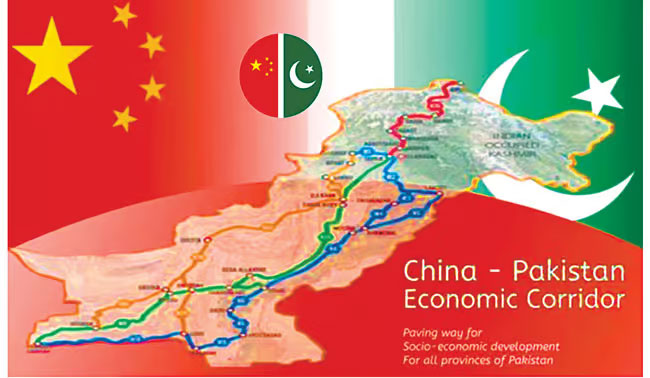IF you look at the regional environment of South Asia at the moment, one thing is clear: India is attempting to imitate China’s pattern of asserting great power status, at times by initiating economic corridors and at other times by projecting itself as a state using coercive means against its neighbours.
India’s recent military aggression towards Pakistan can be attributed to two strategic designs. First, it seeks to establish itself as the regional hegemony in South Asia through military posturing and cross-border actions, particularly against Pakistan. Second, it views CPEC as a threat to its geopolitical and economic aspirations. By destabilizing regions linked with CPEC, India aims to undermine the project and present itself as a viable alternative to China in regional infrastructure and global partnerships—reflecting a broader ambition to counter Pakistan and project itself as a central power in the emerging multipolar global order.
However, India is quite different from China, as it remains deeply entangled in regional conflicts. These tensions occasionally involve Pakistan, Bangladesh, China and often include frictions with Nepal. Persistent border disputes and water-sharing disagreements have strained its relations with these neighbours. India’s desire to project power in the region sometimes clashes with the sovereignty concerns of smaller neighbouring states. Unlike China’s relatively stable regional diplomacy, India’s assertive policies often generate unease in South Asia.
In its pursuit of regional hegemony, India has launched strikes against Pakistan to project itself as a decisive power in South Asia’s security landscape. However, these moves have only worsened its ties with neighbours. India’s apprehension over the China-Pakistan Economic Corridor (CPEC), a key Belt and Road Initiative project, reflects anxiety over its waning strategic clout. CPEC boosts Pakistan’s economy and regional relevance, threatening India’s dominance and maritime interests in the Arabian Sea. Viewing the China-Pakistan nexus as a strategic challenge, India has distanced itself from BRI and backed the India-Middle East-Europe Economic Corridor (IMEC). This shift illustrates India’s effort to reshape regional connectivity while countering China’s growing influence in a multipolar regional order.
The geopolitical landscape of South Asia has undergone significant transformation since the launch of CPEC. Linking China’s Xinjiang province to Pakistan’s Gwadar port, the corridor strategically passes through Gilgit-Baltistan, a region India started to controversially claim as part of its territory. As a result, India has been persistently opposing the Chinese-led CPEC. Over time, India’s objections have evolved from diplomatic and economic resistance to more overt militarized actions, exemplified by aerial strikes such as the Balakot operation in 2019 and again in May 2025. These actions underscore its enduring hostility with Pakistan and a broader strategic rivalry involving India’s competition with China.
India’s military actions against Pakistan, particularly the Pulwama-Balakot episode of February 2019, reflect deeper strategic anxieties under the guise of counterterrorism. The pre-emptive airstrikes, based on contested intelligence, marked a shift in India’s military doctrine and revealed its growing concern over the China-Pakistan Economic Corridor (CPEC). These militarized responses signaled not just retaliation but India’s broader fear that CPEC’s success would undermine its regional ambitions. The timing of the strikes coincided with the completion of CPEC Phase One and the initiation of Phase Two, highlighting India’s apprehension over the project’s expanding influence. New Delhi perceives CPEC as contributing to a strategic encirclement, enhancing Pakistan’s geopolitical relevance while challenging India’s aspirations for dominance in South Asia. The deepening China-Pakistan partnership, symbolized by CPEC, is thus viewed in India as a direct threat to its strategic space and regional leadership, prompting aggressive postures cloaked as counterterrorism operations.
India views CPEC as part of China’s broader “grand strategy” of encirclement, tied to the “String of Pearls” in the Indian Ocean. Fearing China’s expanding presence in Pakistan and potential access to the Arabian Sea, India has adopted coercive diplomacy. The May 7, 2025, airstrikes on Muzaffarabad, Kotli and Bahawalpur—regions near the corridor—reflected India’s willingness to use force to assert regional dominance. While not targeting CPEC directly, the strikes sent a clear strategic message, aiming to project instability and deter investment. This military signaling serves to undermine CPEC’s credibility, preserve India’s strategic autonomy and challenge China’s growing regional influence, while warning both Pakistan and potential stakeholders in the corridor.
India’s militarized posture also reveals deeper anxieties about China’s growing influence in South Asia and the perceived erosion of its regional leadership. As China consolidates its economic footprint through CPEC, India sees its strategic space narrowing. The 2025 airstrikes, like earlier ones in 2019, appear less about immediate retaliation and more about pre-empting long-term shifts in the regional balance of power.
For Pakistan, this shift of India towards military responses to economic projects is not without risks, as New Delhi has not only bypassed diplomatic engagement but also raised the spectre of a destabilized region, where economic cooperation is being undermined. India’s combined use of military action, pretension of infrastructure investment and diplomatic resistance reflects an open opposition to CPEC. This reaction presented a precarious picture for the states’ endeavouring for a broader struggle for regional connectivity and economic stability.
In conclusion, India’s attempts to assert regional hegemony, whether by mimicking China’s strategic posture or through aerial strikes on Pakistan, have so far fallen short. Efforts to sabotage CPEC have not only failed but have also revealed India’s discomfort with shifting geopolitical realities. As the corridor advances, it cements the China-Pakistan partnership and further sidelines India from the emerging regional order. With unresolved border disputes, strained ties with neighbours and an increasingly reactive foreign policy, India’s vision of regional supremacy appears increasingly out of reach. If such miscalculations persist, they will risk India’s image on the regional and global level.
—The writer is Associate Professor of International Relations, National University of Modern Languages, Islamabad.
(srauf@numl.edu.pk)


















